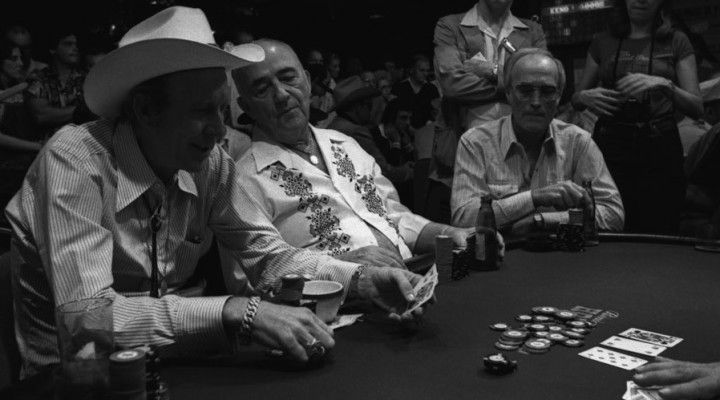Poker Origen Wikipedia
Planning poker, also called Scrum poker, is a consensus-based, gamified technique for estimating, mostly used to estimate effort or relative size of development goals in software development. In planning poker, members of the group make estimates by playing numbered cards face-down to the table, instead of speaking them aloud. The cards are revealed, and the estimates are then discussed. By hiding the figures in this way, the group can avoid the cognitive bias of anchoring, where the first number spoken aloud sets a precedent for subsequent estimates.
- Poker Origen Wikipedia Encyclopedia
- Poker Origen Wikipedia Shqip
- Poker Origen Wikipedia En
- Poker Origen Wikipedia Y
Poker Origen Wikipedia Encyclopedia
Planning poker is a variation of the Wideband delphi method. It is most commonly used in agile software development, in particular in Scrum and Extreme Programming.
The method was first defined and named by James Grenning in 2002[1] and later popularized by Mike Cohn in the book Agile Estimating and Planning,[2] whose company trade marked the term [3] and a digital online tool.[4]
Process[edit]
Rationale[edit]
The reason to use planning poker is to avoid the influence of the other participants. If a number is spoken, it can sound like a suggestion and influence the other participants' sizing. Planning poker should force people to think independently and propose their numbers simultaneously. This is accomplished by requiring that all participants show their card at the same time.
The figure of the jack has been used in many literary works throughout history. Among these is one by 17th-century English writer Samuel Rowlands. The Four Knaves is a series of Satirical Tracts, with Introduction and Notes by E. Rimbault, upon the subject of playing cards. Playing cards may have been invented during the Tang dynasty around the 9th century AD as a result of the usage of woodblock printing technology. The earliest known text containing a possible reference to card games is a 9th-century text known as the Collection of Miscellanea at Duyang, written by Tang dynasty writer Su E.
Equipment[edit]
- Poker is any of a number of card games in which players wager over which hand is best according to that specific game's rules in ways similar to these rankings.
- The game of poker was developed some time during the early 19th century in the United States. Since those early beginnings, poker has grown to become an extremely popular pastime throughout the world.
- Cribbage has several distinctive features: the cribbage board used for score-keeping, the eponymous crib, box, or kitty (in parts of Canada)—a separate hand counting for the dealer—two distinct scoring stages (the play and the show) and a unique scoring system including points for groups of cards that total fifteen.
Planning poker is based on a list of features to be delivered, several copies of a deck of cards and optionally, an egg timer that can be used to limit time spent in discussion of each item.
The feature list, often a list of user stories, describes some software that needs to be developed.
The cards in the deck have numbers on them. A typical deck has cards showing the Fibonacci sequence including a zero: 0, 1, 2, 3, 5, 8, 13, 21, 34, 55, 89; other decks use similar progressions with a fixed ratio between each value such as 1, 2, 4, 8, etc.
The reason for using the Fibonacci sequence instead of simply doubling each subsequent value is because estimating a task as exactly double the effort as another task is misleadingly precise. A task which is about twice as much effort as a 5, has to be evaluated as either a bit less than double (8) or a bit more than double (13).
Several commercially available decks use the sequence: 0, ½, 1, 2, 3, 5, 8, 13, 20, 40, 100, and optionally a ? (unsure), an infinity symbol (this task cannot be completed) and a coffee cup (I need a break, and I will make the rest of the team coffee). The reason for not exactly following the Fibonacci sequence after 13 is because someone once said to Mike Cohn 'You must be very certain to have estimated that task as 21 instead of 20.' Using numbers with only a single digit of precision (except for 13) indicates the uncertainty in the estimation. Some organizations[which?] use standard playing cards of Ace, 2, 3, 5, 8 and king. Where king means: 'this item is too big or too complicated to estimate'. 'Throwing a king' ends discussion of the item for the current sprint.
Smartphones allow developers to use mobile apps instead of physical card decks. When teams are not in the same geographical locations, collaborative software can be used as replacement for physical cards.
Procedure[edit]
At the estimation meeting, each estimator is given one deck of the cards. All decks have identical sets of cards in them.
The meeting proceeds as follows:
- A Moderator, who will not play, chairs the meeting.
- The Product Owner provides a short overview of one user story to be estimated. The team is given an opportunity to ask questions and discuss to clarify assumptions and risks. A summary of the discussion is recorded, e.g. by the Moderator.
- Each individual lays a card face down representing their estimate for the story. Units used vary - they can be days duration, ideal days or story points. During discussion, numbers must not be mentioned at all in relation to feature size to avoid anchoring.
- Everyone calls their cards simultaneously by turning them over.
- People with high estimates and low estimates are given a soap box to offer their justification for their estimate and then discussion continues.
- Repeat the estimation process until a consensus is reached. The developer who was likely to own the deliverable has a large portion of the 'consensus vote', although the Moderator can negotiate the consensus.
- To ensure that discussion is structured; the Moderator or the Product Owner may at any point turn over the egg timer and when it runs out all discussion must cease and another round of poker is played. The structure in the conversation is re-introduced by the soap boxes.

The cards are numbered as they are to account for the fact that the longer an estimate is, the more uncertainty it contains. Thus, if a developer wants to play a 6 he is forced to reconsider and either work through that some of the perceived uncertainty does not exist and play a 5, or accept a conservative estimate accounting for the uncertainty and play an 8.
Benefits[edit]
A study by Moløkken-Østvold and Haugen[5] reported that planning poker provided accurate estimates of programming task completion time, although estimates by any individual developer who entered a task into the task tracker was just as accurate. Tasks discussed during planning poker rounds took longer to complete than those not discussed and included more code deletions, suggesting that planning poker caused more attention to code quality. Planning poker was considered by the study participants to be effective at facilitating team coordination and discussion of implementation strategies.
See also[edit]
- Comparison of Scrum software, which generally has support for planning poker, either included or as an optional add-on.
References[edit]
- ^'Wingman Software Planning Poker - The Original Paper'. wingman-sw.com. Retrieved 5 July 2017.
- ^Mike Cohn (November 2005). 'Agile Estimating and Planning'. Mountain Goat Software. Retrieved 1 February 2008.
- ^'Planning poker - Trademark, Service Mark #3473287'. Trademark Status & Document Retrieval (TSDR). 15 January 2008. Retrieved 26 May 2014.
- ^Cohn, Mike. 'Planning Poker Cards: Effective Agile Planning and Estimation'. Mountain Goat Software. Mountain Goat Software. Retrieved 30 March 2016.
- ^K Moløkken-Østvold, NC Haugen (10–13 April 2007). 'Combining Estimates with Planning Poker—An Empirical Study'. 18th Australian Software Engineering Conference. IEEE: 349–58. doi:10.1109/ASWEC.2007.15. ISBN978-0-7695-2778-9.
- Mike Cohn (2005). Agile Estimating and Planning (1 ed.). Prentice Hall PTR. ISBN978-0-13-147941-8.
The card game “Poker” first was called such around the early 19th century. Despite this happening fairly recently, it isn’t directly known how Poker got its name, but there are two leading theories that more or less coalesce into one very probable origin. The first theory is that it came from the name of a French card game that resembled Poker somewhat called “Poque”.
There was also a German card game that is similar to Poker called “Pochspiel”, which in turn got its name from the German word “pochen” (which is also where the French “Poque” got its name). “Pochen” at the time meant “to brag or bluff”. It should also be noted here that even after Poker got its name, it was also sometimes called “bluff”.
Most Poker historians tend to lean towards the French “Poque” origin, in terms of where the game directly got its name, because Poker seems to have first popped up and spread from New Orleans in the very early 19th century. Not too surprisingly from the location, the French game of Poque was commonly played here, lending credence to the “Poque” origin. Whether that’s the case or the alternate “Pochspiel” derivation, it would seem very plausible and probable that the ultimate origin was from the German “pochen”, which meant “brag/bluff”.

And just for fun, here are a two other origins of other common Poker game terms:
- Bluff: First popped up in this context around the mid-19th century in American English either from “bluffen”, meaning “to brag or boast”, or “verbluffen”, meaning “to mislead”.
- Ante: from the Latin “ante”, meaning “before”, which in turn came from the Proto-Indo-European “*anti”, meaning “facing opposite, before, or in front of”.
*Note: This article is written in cooperation with PokerListings.com; which is the world’s largest online Poker guide featuring breaking Poker news, and detailed Poker strategy articles and videos.
Bonus Poker Facts:

- There are two main kinds of bluffing in Poker, a “pure bluff”, meaning that the only hope of winning is if all others in the game fold, then a “semi-bluff” where the cards held don’t have much hope of winning, but may improve significantly after exchanging or acquiring other cards, depending on the rules of the particular type of Poker.
- Up until the late 20th century, the generally accepted view of the origin of Poker was that it came from the 16th century Persian game “As Nas”, which was played with 25 cards and strongly resembled “Five Card Stud”. It also featured similar “hands” to Poker. This has changed recently with gaming historians noting that the French game “Poque” was commonly played in the regions Poker seems to have first showed up in, and the rules are somewhat similar to Poker, as is even the name. However, it should be noted that there were numerous card games with similar such rules, so the exact origin of Poker is still debated and it may well have derived from rules of multiple existing card games at the time of its inception. One somewhat unique thing about Poker, that set it apart from many other types of card games of the day and drastically bolstered its popularity, was the betting elements incorporated into the game itself.
- One of the earliest documented instances of Poker being played was from 1829 by English actor Joseph Crowell. He stated he played the game in New Orleans that year using a deck of 20 cards and four players, each getting five cards, with bets placed after the cards were dealt. In the early days of Poker, it was common to use fewer cards the fewer people were playing. The game is thought to have spread from New Orleans up the Mississippi on river boats where gambling was extremely popular.
- The ability to draw new cards in certain types of Poker games was introduced sometime before 1850. The ability to have a “wild card” was introduced around 1875.
- One trick as to when to bluff and when not (to optimize one’s chance of coming out ahead over many hands) is to use a randomizing agent to help you determine whether to bluff or not, such as deriving a randomizing method off of the exact time when the hand is dealt or some mental randomizer using the number of cards of a certain color in your hand or the like. When using these tricks, you should also factor in the general odds of winning the bluff, partially based on how many people are in the game and how much you have to put in vs. how much the pot is worth.
- In the sense of “vertical cliff, or flat front”, “bluff” originated from the Dutch “blaf”, meaning “flat, broad”, particularly referencing the flat vertical bows of ships, then later the definition was broadened to refer to certain features of landscape.
- At the time of the game Poker beginning to be called such, the word “poker” had already been around for about three centuries, first popping up in the early 16th century meaning “metal rod”, derived from the word “poke”. “Poke” first turned up in English around the 14th century, probably from the Middle Dutch “poken”, which just meant “to poke”, which in turn came from the Proto-Germanic root “*puk-“.
Poker Origen Wikipedia Shqip
Expand for ReferencesPoker Origen Wikipedia En

Poker Origen Wikipedia Y
| Share the Knowledge! |